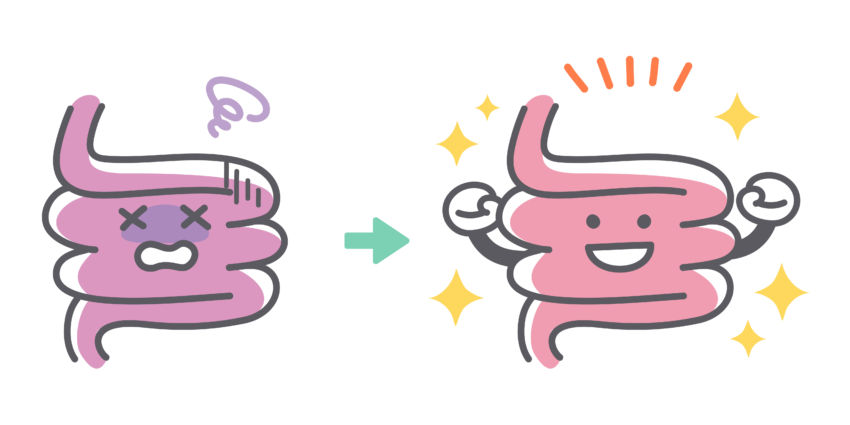Disease begins in the gut. Hippocrates said it 2500 years ago and it remains true even today. Research studies confirm (again and again) that most chronic health issues have a connection to our gut. This includes gastrointestinal ailments like Irritable Bowel Syndrome (IBS) or Inflammatory Bowel Disease (IBD) but also seemingly unrelated health conditions like diabetes, cardiovascular disease, Alzheimer’s, anxiety, depression, eczema, chronic fatigue syndrome, hormonal imbalances, autoimmune conditions, obesity and more.
In addition to these conditions, a wide range of common symptoms are connected to the state of our gut and if you experience any of these on a regular basis, you do want to gear up your gut. Some examples are:
- brain fog
- energy fluctuations
- fatigue
- mood swings
- poor sleep
- skin problems
- food sensitivities
- frequent colds and infections
- histamine intolerance
- hormonal imbalances
- aches and pains
It is easy to see how our gut health plays such a pivotal role in our overall wellbeing: the gastrointestinal tract is where nutrients from the food we eat migrate into our bloodstream. These nutrients are vital for cellular functions. Our gut is also where most of our immune cells reside and where an entire ecosystem of microbes lives to support our body’s biological processes.
A healthy gut looks like this:
- it has a strong and well-functioning barrier that lets in nutrients and keeps out unwanted material,
- it provides a strong “first line of defense” and triggers an appropriate immune response against pathogens or toxins,
- it releases necessary and appropriate digestive secretions that help with the breakdown and absorption of the food we eat, such as enzymes, hydrochloric acid, and bile,
- it houses a well-balanced community of microbiota that help our body’s physiological processes.
In today’s world there are many factors that contribute to a disruption within the gastrointestinal environment: factors such as a suboptimal diet, inflammatory foods, stress, toxins, pollution, antibiotics, medication. Fortunately, there are many things you can do to help restore balance.
In my work with clients the process of gut restoration is very personalized and based on a thorough assessment of underlying imbalances, health history, past and current environmental influences and more. I like to run a functional gut test on many of my clients as well to look “under the hood” and identify their unique imbalances.
In more general terms, an approach that everyone can follow to support good gut health and/or correct imbalances is the “GEARRRRR up your gut” technique otherwise known as the 5 R approach for restoring digestive health. The 5 Rs stand for Remove, Replace, Repair, Reinoculate and Rebalance.
1. Remove
In this first phase you remove all the things that are contributing to a compromised gut. This includes foods that you are known gut irritants, like refined sugar, processed foods and industrial seed oils. For many people gut irritants include gluten and dairy products. It also includes foods you are sensitive or allergic to.
A short (30 day) elimination diet during which you remove all these irritants can help provide your gut with the rest it needs to heal and repair itself.
During an elimination diet you eliminate all potential culprits and observe the impact this has on your health. After the elimination phase you reintroduce foods one by one and observe how you respond to these foods. This helps to identify which foods are contributing to your symptoms. In my practice I like to use a food & symptom journal tracking system that lives on my online client management portal to help makes this process easier.
The Remove phase may also include removing pathogenic micro-organisms, such as overgrown bacteria, yeast, or parasites. A functional test can help identify if such pathogens are present and help determine the best course of action.
2. Replace
Replace refers to the digestive secretions that are naturally released during the digestive process, such as stomach acid, digestive enzymes, and bile. In a compromised gut these secretions are often not flowing optimally. You may need to support these secretions with supplements, such as digestive enzymes or herbal bitters. You can also use easy home remedies that stimulate digestive secretions, like taking apple cider vinegar in water before meals. Simple lifestyle practices such as mindful eating in a calm and relaxed environment can help improve the digestive process as well.
3. Reinoculate
In the Reinoculate phase, you focus on restoring the beneficial microbiota that live in your gut. These are the micro-organisms that help support your digestion, synthesize important nutrients, keep your immune system in balance and release substances that act as important signaling molecules in our body. You can boost the diversity and abundance of these beneficial bacteria in a variety of ways. The most powerful way is by increasing your intake of a large variety of plant-based foods that feed these bacteria: foods that are high in fiber and phytonutrients. The second way is to consume fermented foods, which contain beneficial bacteria and gut healing nutrients, such as kimchi, sauerkraut, kefir, or yoghurt.
4. Repair
The lining of our gastrointestinal tract is an important barrier that separates the outside world from the inside of our bodies. It is like a gateway that allows entry to nutrients from the food we eat and that keeps out potentially harmful material so it can be excreted. A compromised gut barrier, also known as a leaky gut, has lost its ability to keep unwanted material out.
Behind our gut barrier there is an army of immune cells waiting and a continuous influx of foreign invaders such as food molecules, toxins, and bacteria creates an inflammatory cascade that eventually results in immune system alterations. This is the process involved in increased food sensitivities, allergies, skin problems, susceptibility to colds and infections, autoimmune disease, and many more immune-related health issues.
Repair and healing of the gut barrier is an important part of gut health restoration. The previous phases of the 5R approach provide the foundation for this repair. In the Repair phase, certain gut healing foods can be used to further support the healing process. Bone broth is one of these healing foods as is stewed apple, a rich source of pectin. You may want to use certain supplements such as collagen peptides, L-glutamine, zinc carnosine or immunoglobulins to give the repair process an extra boost.
5. Rebalance
In this phase you examine lifestyle factors that play an important role in gut health and you incorporate the necessary changes to support gut healing.
Stress for example is a known disruptor of gut immunity and our gut microbiome. In order to support gut health, you will want to examine and address the stressors in your life, as well as incorporate stress management techniques such as breathing practices or meditation.
Similarly, not enough or even too much exercise can disrupt our gut function, as can poor quality sleep.
As you can see, the “GEARRRRR up your gut” technique provides a holistic, step-by-step approach and an easy template to get started with restoring gut health. The benefits of doing this are tremendous and will help improve your health and boost energy, productivity and focus.
If you feel you need help with this or like a highly personalized approach, please schedule a free strategy session with me here so we can talk about your challenges and goals in more detail and decide on a personal plan of action on how to gear up your gut.
Be Well.



